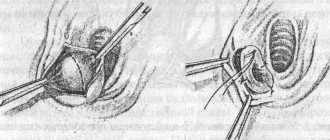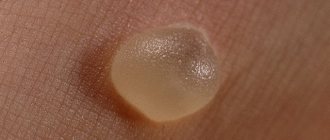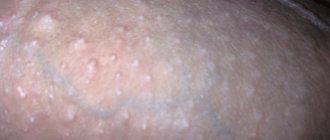The human intimate area is rich in both sebaceous glands and hair follicles. Consequently, the appearance of various inflammatory diseases is quite common. Atheroma (benign tumor) on the labia is an unpleasant disease that can not only complicate the basic functions of the sexual organ, but also lead to dangerous complications. A woman needs to take this illness responsibly and seek help as soon as the first symptoms appear.
What is atheroma?
Atheroma in the groin is a rounded compaction that occurs due to blockage of the excretory duct in women. Since the secretion is not removed, it forms a cyst or atheroma. It consists of a capsule filled with liquid contents. There may be pus or blood clots inside (if the vascular walls are damaged).
A rounded compaction that occurs due to blockage of the excretory duct.
Unlike lipoma, this neoplasm is more mobile. In women, it rolls under the skin if you touch it with your finger. The lipoma remains in place, while the atheroma on the labia moves in different directions. The lump often contains a black dot. It is a blockage of the duct, which is located in the center.
Benign tumors are often localized where the sebaceous glands pass. In the groin of women, the contents sometimes leak out of them and settle on the skin. They smell bad.
What kind of disease
Atheroma is a benign formation, often with a genetic predisposition. An epidermal cyst looks like a thickening of the skin.
It consists of sebum and dead cells. Inside there is a white-yellow liquid with an unpleasant odor.
It is formed due to blockage of the sebaceous duct, then the discharge from it begins to accumulate under the skin and mixes with keratin. Atheroma can grow to large sizes if no measures are taken to eliminate it.
On this topic
Can an ovarian cyst resolve on its own?
- Editorial board of Oncology.ru
- October 16, 2021
The tumor can be large or small, grow quickly or not change in size. Sometimes it can open on its own, then the liquid contained in it will flow out.
In such cases, it is important to prevent infection from entering the middle of the capsule, which can lead to infection. That's why it's so important to see a doctor.
Causes
Atheroma occurs on the labia, pubic area, vulva and other groin areas. The exact reasons for its formation are unknown. Experts name the main risk factors due to which women may encounter a neoplasm:
- hormonal disorders, endocrine disruption;
- mechanical damage to the skin, increased trauma to the skin and hair follicles;
- hereditary factor;
- frequent use of underwear made of synthetic materials that restrict movement;
- excessive use of low-quality cosmetics intended for intimate care for women;
- failure to comply with hygiene rules;
- bad habits (alcohol, smoking);
- eating large amounts of fatty, spicy foods, as well as confectionery;
- diseases associated with excess sebum production.
Frequent depilation provokes injuries to the hairline and, as a result, atheroma appears in the groin. In addition, its formation in women is facilitated by diseases of the genital area.
Care after removal and prevention of occurrence
After surgery, when the atheroma on the labia is eliminated, the woman should follow some recommendations for wound care:
- wear exclusively natural underwear;
- refrain from intimacy until the wound heals;
- on the first day it is advisable not to wet the affected area;
- add low concentration antibacterial agents (chamomile, furatsilin, potassium permanganate) to bathing water;
- temporarily stop using cosmetics.
This will help speed up the healing process and prevent bacteria from reaching unprotected areas.
To prevent relapse of the disease, you need to take care of your health. You should regularly visit a gynecologist, monitor your hormonal levels, and do not neglect the rules of personal hygiene. You need to monitor your own weight, since disruption of the sebaceous glands is most often associated with this factor. Proper balanced nutrition and giving up bad habits will help prevent the development of various health-threatening diseases.
Any neoplasm in the genital area signals the need to urgently consult a doctor. If you ignore the symptoms of the disease and try to treat the tumor yourself without an accurate diagnosis, you can worsen the patient’s condition. Despite its benign nature, a growth of this type can lead to the development of complex pathological processes.
- 4 minutes to read
Atheroma, or epidermal cyst on the labia, is considered a common problem in women. The cystic neoplasm is localized in the area of the sebaceous glands and hair follicles.
Content
Mostly such formations appear on the head, neck, face, and also in the groin area. You need to know what kind of disease this is and what methods can be used to treat it.
Symptoms of atheroma
When atheroma appears in the groin in women, signs may not appear for a long time. In most cases, this tumor slowly increases in size, so it does not bother the woman. It is often not noticed until a mechanical injury occurs that damages the capsule.
The body temperature rises, the thickening hurts even when it is not touched.
In this case, an inflammatory process develops. The body temperature rises, the thickening hurts even when it is not touched. The affected area swells.
In women, the appearance of atheroma on the labia is accompanied by the following symptoms:
- the tumor is mobile, moves under the fingers and is not tied to a specific place in the groin;
- Abscessation of the labia majora contains a dark dot in the center - a blocked duct;
- When inflamed, the skin in the localized area in women turns red and becomes hot to the touch.
Since perineal atheroma is located in a sensitive area, underwear or clothing often puts pressure on the capsule, causing constant friction. Because of this, a tumor in women can spontaneously open. In this case, the unpleasantly smelling light-colored contents will end up on the skin and underwear. After this, the capsule will begin to fill again and the thickening will form again.
Preventive actions
Surgery to remove atheroma on the labia is only part of the treatment. It is very important after surgery to prevent atheroma from forming again.
Benign neoplasms appear in different parts of the body when the excretory ducts are blocked. In the presence of risk factors, atheroma may form on the pubis in women. Since it can reach large sizes, its removal is indicated. Large lumps cause discomfort, and an inflammatory process can develop inside them.
Danger of complications
In most cases, in women, atheroma in the groin does not pose a threat to life or health. However, this statement is valid only until the neoplasm reaches a large size and there is a risk of its suppuration. The contents can penetrate the internal tissues, and sepsis will develop.
If the thickening is not removed in time, the woman risks encountering the following complications:
- an infection will penetrate into the wound, which will provoke increased growth of a benign tumor;
- the process of suppuration leads to spontaneous rupture of the capsule and the entry of purulent contents into the body;
- benign atheroma in some cases can transform into cancer;
- if the membrane opens spontaneously, long-term non-healing wounds often form in its place.
Therefore, if a suspicious lump appears in the groin area, a woman should definitely visit her doctor.
Treatment methods
The most effective method of treating atheroma today is to remove it surgically. Surgery to remove the tumor is performed in almost all cases when it is diagnosed.
Several types of surgery are possible.
Opening and husking the contents
This is a classic surgical method, during which the doctor makes an incision and removes the atheroma capsule along with the fluid it contains, after which self-absorbing sutures are applied. The disadvantage of this method is the possibility of relapse due to incomplete removal of the cyst contents.
Diagnosis of pathology
To accurately determine atheroma on the labia, a woman will need to make an appointment with a gynecologist. The doctor may prescribe an additional consultation with a surgeon. The diagnosis is made based on examination of the groin area, as well as by palpating the lump. Usually this is enough to diagnose the pathology.
An ultrasound is performed before the operation.
Additionally, the doctor takes a smear, prescribes an ultrasound, as well as a biopsy. Using a puncture, the contents of the capsule are pumped out and then sent for histological examination. This will exclude the malignant nature of the tumor.
general information
If the gland becomes clogged, it stops removing sebum, which accumulates, over time forming mobile nodes of varying sizes. They are mistakenly called wen, although they have a different name.
Atheroma is a cyst of the sebaceous gland, and occurs at the site of its blockage. These growths can appear on the face, arms or back; they are lumps that look like a pimple, but do not cause redness and are not painful when pressed. It is not a tumor or an inflammatory disease, does not cause deterioration in health and remains, to a greater extent, an exclusively cosmetic defect.
Treatment of sebaceous cysts in the groin
For atheroma, the same treatment methods are used as for other cystic formations. Since they are not amenable to drug therapy, the woman is recommended to have the capsule removed surgically.
However, if there is suppuration, the procedure is not carried out. In this situation, drugs are first used to eliminate the inflammatory process, and then surgery is prescribed.
Removal methods
To eliminate atheroma, doctors use one of the following intervention methods:
- classic surgical operation. This is the most common way to remove benign tumors in women. With this type of intervention, the skin is excised, as well as the capsule is opened. It is removed along with the contents, then stitches are applied. The operation is performed under local anesthesia and is most often prescribed if the lump has reached a large size. In this case, traces of the stitches remain, and they are removed after a couple of weeks, after the excised tissue has healed. The possibility of re-development of atheroma with the classical procedure is minimized;
The operation is performed under local anesthesia and is most often prescribed if the lump has reached a large size. - Radio wave radiation involves the destruction of the structure of neoplasm cells using radio waves. During the operation, the woman experiences virtually no discomfort; moreover, it does not last long (a few minutes). There are no scars left at the site of exposure, but only a small depression appears, which will disappear in the future;
- The laser procedure is used for different types of cystic lesions. Using a laser, the atheroma is opened using a bloodless method. The skin is instantly cauterized, so the risk of tissue infection is minimized. Using a small incision made with a laser scalpel, the neoplasm is opened and the capsule is cauterized, simultaneously removing its contents. After the operation, the sebaceous masses are evaporated and the membrane is destroyed. Relapse is excluded.
If a woman has inflammation of the atheroma or its spontaneous opening, treatment with antibiotics and treatment with antiseptic drugs is prescribed. After removal of the purulent contents, 2 to 3 months must pass before the surgical procedure can be performed.
Treatment methods for atheroma on the genitals
Treatment of neoplasms on the labia is carried out using several methods. Conventionally, they can be divided into traditional and non-traditional, conservative and radical.
An unconventional method includes treatment using traditional medicine. For this, a variety of herbal preparations, kitchen ingredients, and nutritional supplements are used. Medicines for external and internal use are prepared from these components. Various tinctures, ointments, and decoctions, according to adherents, help effectively combat formations.
Conservative traditional treatment consists of the introduction of special drugs. The substance is injected into the body of the tumor. A few months after the start of the procedure, the growth begins to resolve.
This method is effective only for small atheromas. Especially large growths may not resolve completely, which will lead to the recurrence of tumor formation.
A radical solution to the problem is to remove the atheroma in one of several ways:
- surgical excision of the formation;
- laser excision;
- removal of the tumor using radio waves.
The treatment method is selected individually, depending on the results of the diagnostic study.
Rehabilitation after surgery
The intervention itself takes little time, but after it the woman requires care and medical supervision for several months. In most cases, sutures are used that dissolve on their own 1 to 2 weeks after the operation.
The site where the atheroma is removed is treated daily with an antiseptic.
During the recovery period, you will need to take medications prescribed by the doctor, as well as daily treat the area where the atheroma was excised with antiseptic solutions. This procedure must be performed several times a day to prevent the wound from becoming infected.
For 2–3 days after surgery, water should not come into contact with the seam. You can swim only after this. On average, healing takes about 2 weeks. If classic atheroma removal was used, a small scar will remain on the skin. However, after a few months it will be practically invisible.
If there is a benign tumor in the groin area, mandatory monitoring by the attending physician is required. Atheroma does not heal on its own, so it must be removed. The operation is performed using the classical surgical method or using a laser or radio waves. The recovery period lasts on average 2 weeks.
How does the removal work?
Radical treatment, which consists in removing the cyst on the labia, is a necessary measure in cases of the onset of the inflammatory process. If the growth is not eliminated, suppuration will begin. The result is a tissue abscess, which can develop into necrosis.
Surgical removal is the most common method of solving this problem. Actively used for large growth of atheroma. During the operation, the required area is treated with an anesthetic solution. The skin over the tumor is cut along the poles. After this, using tweezers or a clamp, they begin to pull out the atheroma, gradually separating the tissue. At this stage, it is very important not to damage the growth capsule, otherwise the contents will spill onto the wound areas. The operating doctor must be as careful as possible. The removal must be complete. If even a small piece of tumor remains, a relapse may occur. At the end of the operation, the incision site is sutured, and the patient goes home.
For small tumors, laser or radio wave excision is used. Laser removal is carried out using local anesthesia. Using a special device, the cyst tissue is cut out layer by layer. The procedure, thanks to coagulation, is completely bloodless. Treatment with radio waves is a quick, painless and bloodless way to eliminate cysts in the groin area. During the event, the electric current is converted into high-frequency waves that affect the tumor. In this case, there is no direct contact with the skin, which prevents the formation of scars and scars.
Prevention
Despite the fact that the anomaly often develops for reasons independent of the patient’s habits and lifestyle, it is still possible to minimize the risk of its development.
The following will help prevent lipomas from appearing in the intimate area:
- body weight control and proper nutrition, with a minimum amount of animal fats;
- physical activity – it reduces congestion in the pelvic area and normalizes metabolic processes;
- taking special medications from the statin group - they reduce the number of fatty fragments in the circulatory system and stop the development of atherosclerosis. It has been scientifically proven that the agents prevent the formation of lipomas, and if they are present, they slow down the growth and reproduction of affected cells;
- maintaining personal hygiene - most diseases of the labia occur against the background of parasitic skin lesions;
- avoiding injury - the skin in the intimate area is too delicate and sensitive to any external negative influence, which can lead to injury, cracks and damage to the surface dermal layer.
If you find an error, please select a piece of text and press Ctrl+Enter.
Inflammation of the labia in women, video
Sources:
- ROLE OF INFECTIONS IN THE GENESIS OF VULVA DISEASES. Reutskaya M.A., Kulinich S.I. // Siberian Medical Journal (Irkutsk). – 2010. – No. 6. – pp. 239-242.
- CLINICAL AND MORPHOLOGICAL PRINCIPLES OF TREATMENT OF CHRONIC VULVITIS. Kulinich S.I., Reutskaya M.A., Pokinchereda T.V., Ezhova I.V. // Acta Biomedica Scientifica. – 2013. – No. 5 (93). – P.42-48.
- Diseases of the cervix, vagina and vulva: Clinical lectures. Ed. V.N. Prilepskaya. // M.: MEDpress. – 1999. – P. 432.
- Recurrent vulvovaginal candidiasis: etiology, pathogenesis, treatment. Levonchuk E.A. // Med. news. - 2001. - No. 4. — P. 40-43.
- Dystrophic diseases of the vulva. Diseases of the cervix, vagina and vulva. Ed. V.N. Prilepskaya. // M.: MEDpress. – 1999. – P. 326-336.
- https://simptom-lechenie.ru/en/vulvit-u-zhenshhin-i-devochek-simptomy-i-lechenie.html
- https://www.thenakedscientists.com/science-articles
- https://woman-centre.com/vlagalische-i-vulva/vulvit/vulvit-u-zhenshhin.html
- https://simptomer.ru/bolezni/zhenskie-zabolevaniya/864-vulvit-simptomy











